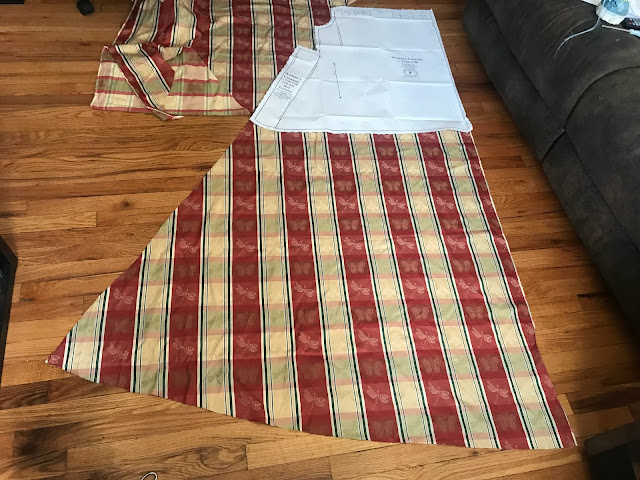I have a really hard time resisting fabric. Especially cheap fabric.
I really like butterfly and dragonfly prints. Really like them.
A large amount of cheap fabric featuring butterflies and dragonflies? Yeah, that came home with me.
It was a large bundle of some sort of poly/cotton drapery cloth (best I can figure) at my local antique mall. $7.50. That's right - seven dollars and fifty cents! Stripes of red and yellow and green, with motifs of butterflies, dragonflies, and bees woven into the design - pretty and intriguing!
I left it behind. That's right, I left it. And instantly regretted it.
I left it behind because I have a LARGE fabric stash - and I really, really, didn't need to add to it. What would I make out of a large amount of insect covered drapery fabric anyway??
But. The butterflies. The amazing price.
I couldn't resist. The next morning I went back and bought the fabric.
Now what would I make from it?
This was summer 2021, shortly after I got married. A year earlier, my friend Anna made the most delightful Robe Volante, and after reading all about it, this style of dress from the early 1700's really intrigued me. I decided I might as well us my quantity of stripey insect fabric to make my own Volante.
Was my fabric choice historically accurate? Noooo. . . . .
But I felt like it had the "spirit" of some of the bizarre silks from the era, so I could get away with it. Besides, how often do I actually need a perfectly accurate 1730's dress? Probably never. So I might as well embrace the slight bizarre-ness of this insect drapery fabric, and make the early 18th century tent dress.
So, with that said, what is the Robe Volante? It is the 1720's - 1740's precursor to the iconic Robe a la Francaise. Like the Francaise, it features loose flowing back pleats, but unlike the Francaise, the front is rather loose and pleated as well. This blog post tells some of the history and shares several beautiful examples of the Volante and it's related garments.
After reading everything I could find online about the Volante and its sisters - the Battante and Casaque - I decided I wanted my Volante to resemble those from the 1720's. Later Volantes featured the same double-stacked box pleats in the back as the Robe a la Francaise, but the earlier ones from the 20's could have any arrangement of pleats or gathers in the back - and that sounded fun to me! Also, earlier gowns were often worn over bell-shaped hoopskirts (similar to the farthingales of earlier centuries), whereas later gowns were worn over oblong paniers. I do love my pocket hoops for later in the 18th century, but for this project being able to just wear one of my normal hoop skirts was appealing. Thus, 1720's (ish) it would be!
With all of this decided, it was time to figure out my pattern!
There's a Volante pattern, and a Casaque (the shorter version of the Volante) pattern in The Cut of Women's Clothes, by Nora Waugh, which I examined closely. The shapes weren't complicated - this should be pretty easy to make. I could either drape the pattern, or size it up from the book - then I found an even easier option!
My friend gave me a Burnley and Trowbridge gift card. Perusing their website, trying to decide how to best spend my gift card, I found the Mill Farm Casaque pattern. I could lengthen that and use it to make my Volante! (Just like this blogger did!)
And just like that, my gift card was spent on the pattern.
The pattern arrived in the mail a couple days later and I eagerly cut the pieces out. I held up the front pieces to myself and measured to see how much length I needed to add for my Volante plans.
Then I laid out the fabric and pattern on our small apartment living room floor (It was a tight squeeze. looking back at these pictures now makes me very thankful for our house. I've got plenty of room to cut stuff out now!), and cut that thing out.
I made sure to match up the stripes along the center front, center back, and side seams.
Cutting out the body was easy. Then I got to the sleeves. I looked at the Mill Farm sleeve pattern piece. I looked at the sleeves patterns in Cut of Women's Clothes. I pulled out Patterns of Fashion 1 and looked at the 1740's Mantua sleeve in there. The shapes of the sleeves in the book and the shape of the pattern piece didn't match. Well this was inconvenient. (You may recall I had a similar sleeve issue with my Strawberry Sacque last fall. Commercial patterns are apparently not great at having correctly shaped 18th century sleeves.)
It came to mind that the Larkin & Smith English Gown pattern does have accurately shaped sleeves - there was only one slight issue. 1760's and 1770's sleeves are considerably more fitted than 1720's - 1740's sleeves. Thus, that sleeve pattern would be too small for my Volante. Now what?
An idea dawned on me, a local friend, a couple sizes larger than me owned the Larkin and Smith pattern too - and her larger sleeve pattern might just work for my Volante sleeves.
I texted her and asked if I could borrow the pattern piece. She dropped it by, and it worked beautifully!
Perfectly shaped, loose, 18th century sleeves!
Next time I'll tell you how all the pieces went together!













Wow. Girl you amazing. Very interesting piece.
ReplyDeleteThis is awesome and so is the setting. Where are you?
ReplyDeleteThank you! My friend took these pictures for me at the Renaissance Festival.
Delete